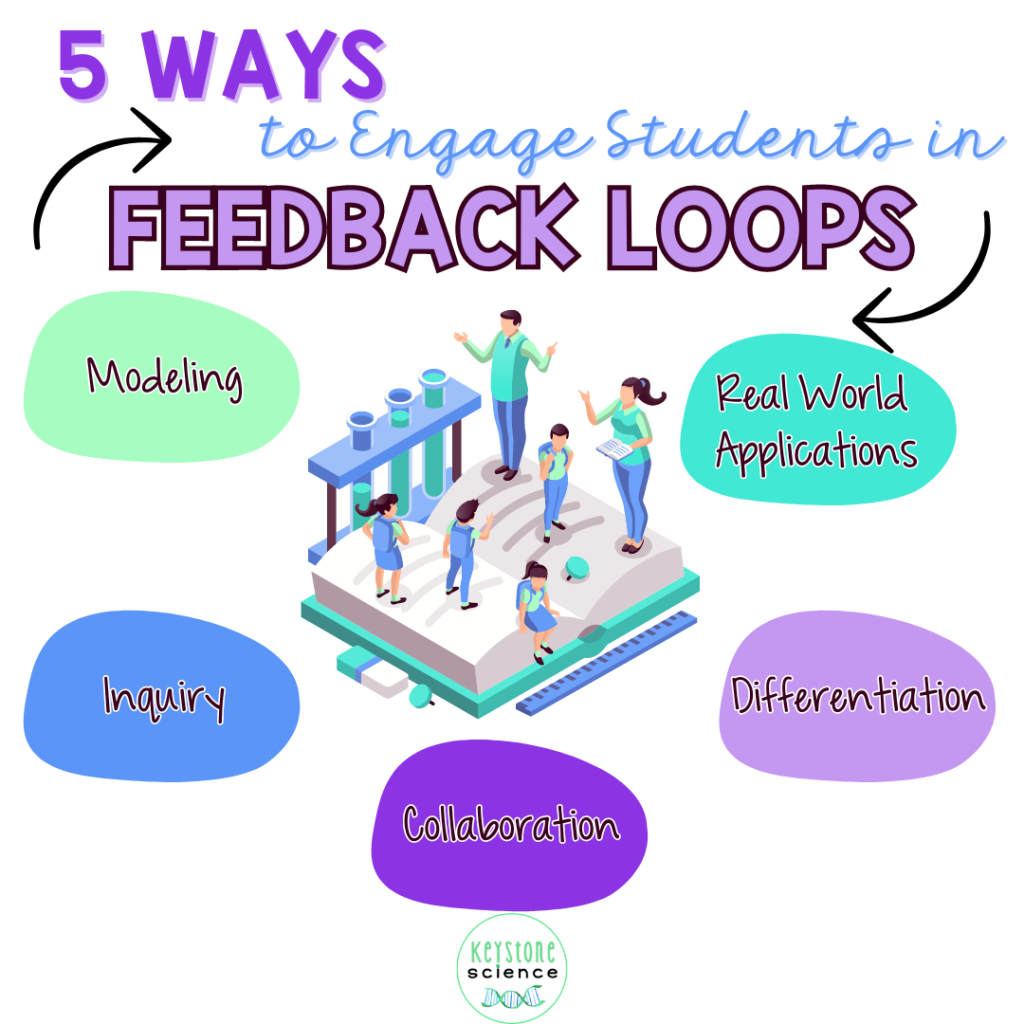We all know the hip bone’s connected to the backbone and the backbone’s connected to the… well, you know the song! But it’s not just the bones in our bodies that are connected. Many of our body’s internal systems work as part of feedback loops that profoundly affect our ability to function. In biology, this is a fundamental concept for students to understand the human body’s internal regulation to remain stable, aka homeostasis.
Feedback loops are a complex topic for both teachers and students but there are options to simplify such a complex topic into something more manageable to teach!
Grasping complex systems – feedback loops – such as glucose and water regulation in humans is critical for students’ development of scientific skills, particularly in biology courses and particularly if there’s a desire to pursue science beyond high school.
What Are Feedback Loops and Why Are They Vital in Biology?
Homeostasis is the state of stability in the body’s physical systems. Positive and negative feedback loops are the system’s way of maintaining or encouraging that stability.
A positive feedback loop, such as blood clotting, is one where the body responds with a more intense reaction designed to bring the body back to homeostasis – stability. When the body is bleeding, it triggers a positive feedback loop where the blood clots in an attempt to close the wound and stop the bleeding.
A negative feedback loop is when the body’s system reacts in order to reduce a change and return to homeostasis – stability. Body temperature regulation is an example of a negative feedback loop. When our body’s temperature drops below normal, our system reacts in a negative loop, which leads to shivering and constricting blood vessels. These then counteract the low temperature by conserving heat and energy to return to homeostasis (in this instance, a normal body temperature).
In high school science, studying and understanding this process is a key part of the expectations of NGSS. The standard NGSS HS-LS1-2 outlines the need for students to “develop and use a model to illustrate the hierarchical organization of interacting systems.” And learning about homeostasis through an examination of positive and negative feedback loops meets that standard.
With this in mind, how can teachers best help their students learn the what, why, and how of feedback loops?
Start with this freebie which gives an overview of feedback loops.

Then, keep reading for 5 ways to engage your students in learning about this must-teach topic.
5 Ways to Engage Students in Feedback Loops

1. Modeling Feedback Loops in the Classroom
- NGSS urges teachers to use models to demonstrate systems because they are a tool that can better represent a system or part of a system for students to study and gain a better understanding.
- Not every model needs to be a 3D model but if you have playdough or clay, students can create using it. Otherwise, models for representing and studying feedback loops can be developed by students through drawings and/or diagrams. Through the process of creating and studying the model, students will be able to explain how a feedback loop works.
2. Inquiry-Based Learning with Hands-On Diagrams
- Providing a diagram of a feedback loop to students where they must label the different parts reinforces student understanding. This shift to inquiry-based learning is ideal because it provides opportunities to differentiate for the students in class. The differentiated diagrams in this resource accommodate students at different levels of support so you can meet the unique needs of your class.
3. Real-Life Connections: Applying Feedback Loops to Everyday Life
- Examples that connect feedback loops to everyday life can be just the right way to ensure students understand this complex concept. Comparing how to control glucose through a study of hyperglycemia or hypoglycemia in diabetics is a great way to create a real-life connection to feedback loops. Another option is to investigate water regulation using urine concentration (color) to determine levels of hydration.
- This resource has comprehension questions to help make these connections. Students revisit the information they’ve learned about feedback loops in general to identify, explain, and expand on a specific feedback loop example drawn from real life.
4. Collaborative Learning Through Group Work or Stations
- It is true that two brains (or 3 or 4 brains) are indeed better than one! Having students work in small groups where they label feedback loops or identify organs and their roles promotes collaborative learning.
- Another way to make working collaboratively better for students’ understanding of feedback loops is to provide the terms or information for a specific feedback loop and have them draw the feedback loop. This task of creating a model links back to NGSS-suggested approaches to learning.
- Add in movement and collaboration through stations where each feedback loop in the product could be a station. Or extend students’ learning of feedback loops by having each station cover an organ system in the human body with the corresponding feedback loop. There could be stations for the digestive system and the glucose regulatory feedback loop as well as the urinary tract and the water regulatory feedback loop, among others.
- A jigsaw is another way to get students working smarter and not just harder. Assign a feedback loop or body system to each group and ask them to create an activity or presentation to teach the class. With a graphic organizer that includes the different feedback loops to be explained, students take notes from the expert group and then end up with a full reference document for themselves too.
5. Assessing Understanding through Differentiated Tasks
- You can also take a mix-and-mingle approach with the preceding teaching suggestions to differentiate for your students. Whether it’s using print and digital versions or incorporating differentiated readings, diagrams, and comprehension questions, all of these ways can support diverse learners.
This print and digital Feedback Loops resource includes extension questions to support honors or gifted students in class too. The questions focus mainly on medical conditions where feedback loops are disrupted or dysfunction in come way. These questions then require students to complete research, which meaningfully extends their learning.
How the Feedback Loops Product Simplifies Teaching

Simplify the teaching of the complex topic of human feedback loops with a differentiated approach. Since classes include varied learning levels so too does this resource. With 70 pages of material, this comprehensive resource has two-level readings, scaffolded step-by-step instructions, leveled comprehension questions, and more.
The digital option of the resource has a drag-and-drop option for diagram labeling so students have ready-supplied terminology that they can apply to a provided diagram.
There are also comprehension questions designed to engage students in critical thinking so it goes beyond just having students answer what is a feedback loop to how they work and why they are necessary.
Whether you’re teaching in a 1:1 environment where each of your students has access to a device, you have a mix, or even if you’re in a tech desert, the digital and print versions offer flexibility no matter the set-up of your teaching environment.
Why Feedback Loops are a Must-Teach Topic
Understanding key concepts in biology is not just a requirement for curriculum coverage but is helpful beyond your classroom. Understanding the role of feedback loops in homeostasis is one of those foundational concepts that students will benefit from learning.
Diving into the concept through NGSS and using this resource, makes this must-teach topic one that will support the development of students’ scientific skills.
Making Feedback Loops Easy to Teach and Fun to Learn
Knowing how our bodies work is a take-away lesson that can serve students long after they leave our classrooms. You need only take a look at the case study of Hold Your Wee for a Wii radio contest where one of the contestants died of hyponatremia – water intoxication. So it might be safe to say that knowing about feedback loops – homeostasis – can save your life!
And an easy way to teach feedback loops and homeostasis is with this differentiated digital PPT activity and printable PDF activity! It introduces students to negative and positive feedback loops to help them understand the importance of maintaining homeostasis, glucose regulation, water concentration regulation, body temperature control, and calcium regulation in the human body.
Looking Ahead
Mole Day is coming on October 23! It starts at 6:02 am and ends at 6:02 pm. The next post will help you mark that day in your classrooms with teaching tips and tricks all about Avogadro’s Law & Ideal Gas Law.
Let’s Connect!
💡Feel free to explore Keystone Science for ready-to-use high school biology & ecology NGSS aligned notes and activities.
💡Subscribe to my email list for weekly tips direct to your inbox.
💡Follow me on Instagram for daily tips, motivation, and facts you can use in your classroom!
🌟Share in the comments or email me directly 👉🏻 [email protected]













